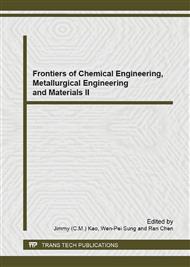p.26
p.30
p.35
p.39
p.43
p.47
p.54
p.60
p.64
A Research on Waste Water Treatment Method of Marine Desulfurization Washing System
Abstract:
As the increasingly strict emission regulations, develop new and efficient desulfurization equipment, to meet the requirements of future Marine sulfur emissions control, ensure freedom of navigation in all waters of the ship, we need to desulfurization of diesel engine emissions. Waste desulfurization generated also need to process and strict inspection to reach the discharge standard of corresponding IMO. The main purpose of this paper is to study a new system for processing waste engine emission for marine diesel engine, this system will make waste liquid treatment becomes more efficient, energy saving, but also saves the cost of waste water treatment. This paper introduces a new technology for processing ship washing desulfurization waste liquid, we analyze the advantages and disadvantages of this equipment. Finally, this method gives the improving measures for the problems and prospects for the development trend of ship desulfurization wastewater treatment.
Info:
Periodical:
Pages:
43-46
Citation:
Online since:
September 2013
Authors:
Keywords:
Price:
Сopyright:
© 2013 Trans Tech Publications Ltd. All Rights Reserved
Share:
Citation:


